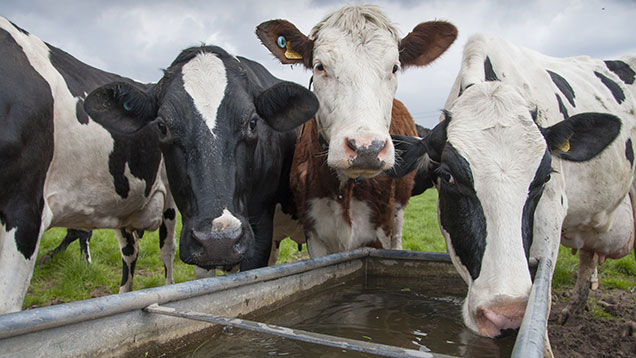Dairy farmers could poison cows by feeding too much copper
 © FLPA/Rex Shutterstock
© FLPA/Rex Shutterstock Dairy farmers could be unknowingly poisoning their cows to death by feeding them too much copper, a recent study has showed.
Researchers at Nottingham University found when more than 500 cull cow livers were tested at random for copper concentrations, 40% of dairy cow livers had copper levels above the AHVLA reference range. This compares to only 16.9% of beef animals.
This indicates a high proportion of the UK herd is at risk of copper toxicity, says Nigel Kendall, lecturer in nutrition at Nottingham University.
The current EC regulation says cows should only be fed maximum copper levels of 35 mg/kg (88% dry matter), which equates to 40mg/kg of total diet DM.
See also: Cows being fed copper at alarmingly high rate
However, many dairy cows are receiving levels higher than this because diets are being formulated to the maximum levels and above requirements, says Dr Kendall.
“Cows are receiving copper from a range of sources, such as dairy cake, drenches and free-access minerals, leading to overloading in the liver. Often the additional sources of copper are not taken into account and can lead to copper accumulation,” he says.
Copper misunderstandings
On top of this, dairy farmers may also be oversupplementing copper due to misunderstandings over copper lock-up, caused by molybdenum and sulphur.
“The concept of copper lock-up has led to a lot of inappropriate supplements,” he adds.
“Many people believe the only effect of molybdenum and sulphur on ruminants is to lock up copper and prevent its absorption, whereas in fact, molybdenum and sulphur will combine in the rumen to form thiomolybdate, which has a high affinity for copper. The problem is actually the thioimolybdate binding to copper rather than a lack of absorbable copper.”
Dr Kendall says even when there are high levels of molybdenum, it doesn’t necessarily mean you are going to have a problem with copper.
“Quite often farmers think ‘if I add a little and I get a response then I will add a lot and get a better response’. Unfortunately, nature’s law of diminishing returns applies and there is the additional issue that too much is toxic.”
Early warning signs
The first time a farmer may realise there is a problem is when there is a dead animal. This is caused by copper toxicity.
However, many dairy cows could be living on a knife-edge with livers overloaded with copper. However, there are no symptoms for this.
Dr Kendall adds: “To go from copper loading to copper toxicity you need some sort of stressor, such as a change in the diet, fluke, or anything that affects the feed intake of a cow. When this happens, the liver just goes bang and releases all of the copper into the blood.”
What should you do?
The first thing farmers should do is an audit of how much copper is being fed. This must include copper from feed, water and supplements.
Farmers can monitor copper levels by taking liver samples from cull and casualty cows and getting them tested, ideally in consultation with their vet/nutritionist.
If high levels of copper are found, farmers should work with their nutritionist/vet to try to bring levels down. However, Dr Kendall warns it is not a quick process – it can take up to 18 months to bring levels of copper in the liver down, even when copper is completely removed from the diet.
